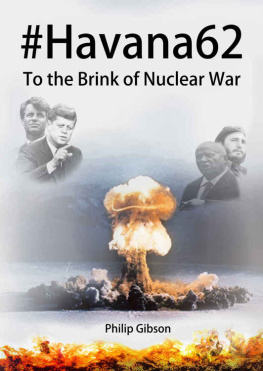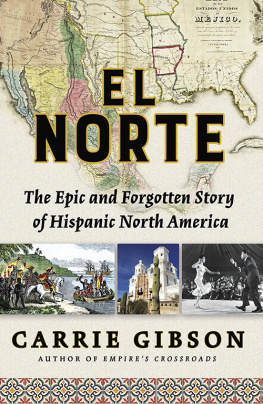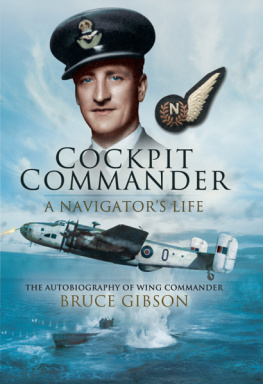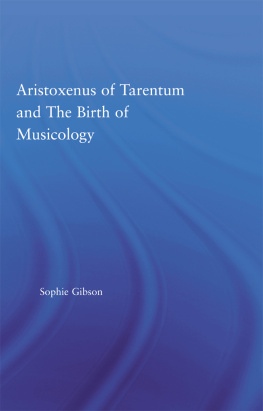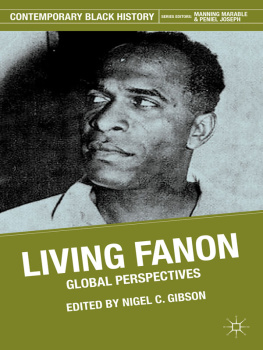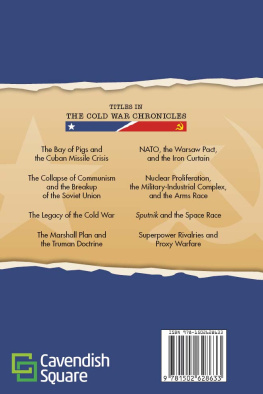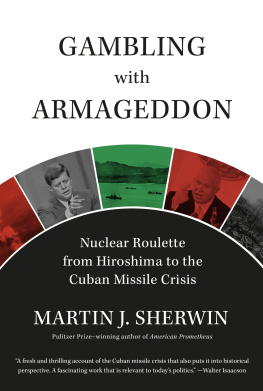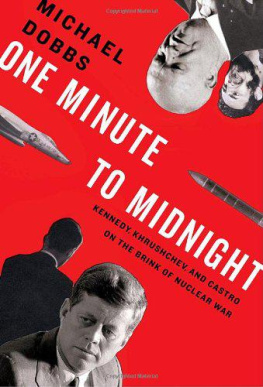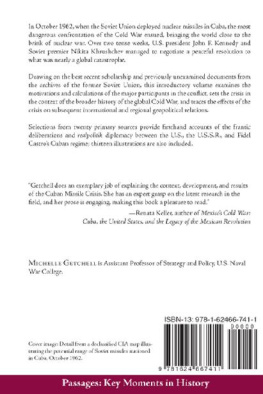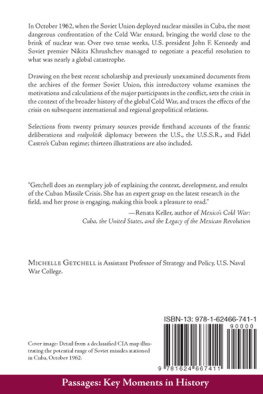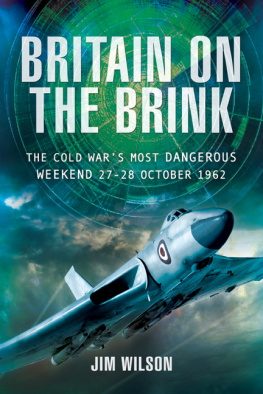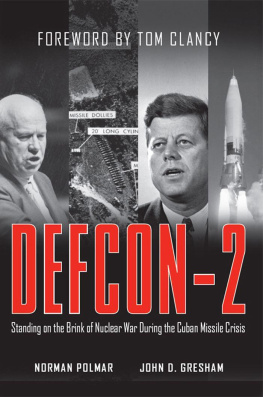Gibson - To the Brink of Nuclear War
Here you can read online Gibson - To the Brink of Nuclear War full text of the book (entire story) in english for free. Download pdf and epub, get meaning, cover and reviews about this ebook. year: 2014, genre: Politics. Description of the work, (preface) as well as reviews are available. Best literature library LitArk.com created for fans of good reading and offers a wide selection of genres:
Romance novel
Science fiction
Adventure
Detective
Science
History
Home and family
Prose
Art
Politics
Computer
Non-fiction
Religion
Business
Children
Humor
Choose a favorite category and find really read worthwhile books. Enjoy immersion in the world of imagination, feel the emotions of the characters or learn something new for yourself, make an fascinating discovery.
To the Brink of Nuclear War: summary, description and annotation
We offer to read an annotation, description, summary or preface (depends on what the author of the book "To the Brink of Nuclear War" wrote himself). If you haven't found the necessary information about the book — write in the comments, we will try to find it.
To the Brink of Nuclear War — read online for free the complete book (whole text) full work
Below is the text of the book, divided by pages. System saving the place of the last page read, allows you to conveniently read the book "To the Brink of Nuclear War" online for free, without having to search again every time where you left off. Put a bookmark, and you can go to the page where you finished reading at any time.
Font size:
Interval:
Bookmark:
Fact-filled accounts of important historical events written in the form of todays social media
*****
The Hashtag Histories books so far:
#Berlin45: The Final Days of Hitlers Third Reich (European Theater)
#Tokyo45: The Final Days of World War II (The Pacific War)
#Havana62: The Cuban Missile Crisis-To the Brink of Nuclear Apocalypse
#Houston68: Apollo 8 The Longest Journey
#Houston69: Apollo11-When Men Walked on the Moon
#Houston70: The Miracle Journey of Apollo 13
The APOLLO Collection How America Won The Race To The Moon
See the Books at: http://amzn.to/1qBn3jw
*****
More Hashtag Histories books are in the works. To be notified of new releases at seriously-discounted prices for a limited time, and to receive a free book, please sign up at: http://eepurl.com/JdUzj
Table of Contents
#Havana62
To the Brink of Nuclear War
What if there had been social media during the Cuban Missile Crisis?
This is not a story told in the usual book format. It is the story of the Cuban Missile Crisis told as if through posts on private social media feeds. The book follows the thoughts and actions of the main participants in the drama based on what those participants actually reported, or could have believably reported in private social media accounts, given who they were, what they knew and where they were at the time.
The year is 1962. John F. Kennedy is in the White House. Nikita Khrushchev is in the Kremlin and Fidel Castro is in the Presidential Palace in Havana, Cuba. For a time, now widely referred to as the most dangerous moment in human history, these men hold the future of modern civilization in their hands as the world teeters on the brink of nuclear apocalypse.
There are several more Hashtag Histories in the pipeline. If you would like to receive email notification of new releases as soon as they are published, please sign up here .
John McCone (19021991)

John McCone was the 6th. Director of the U.S. Central Intelligence Agency and served in that capacity from 1961 to 1965. He was one of the key figures in the Executive Committee of the National Security Council (ExComm) during the 1962 Cuban Missile Crisis.
John McCone @CIADirectorMcCone
The New Year's Day parade in Havana, Cuba is providing us with the first reliable intelligence on the extent of Soviet Bloc arms deliveries to Cuba.

Soviet-made tanks on parade in Plaza Jose Marti in Havana (January 1, 1962).
John McCone @CIADirectorMcCone
Aircraft assets in the possession of the Cuban Revolutionary Air Force are estimated to include around sixty Soviet-built jet fighters, primarily MiG-15 and MiG-17 aircraft.
George McManus @McManusCIA
There are also a limited number of somewhat more advanced MiG-19 planes, plus small numbers of helicopters and light transport aircraft which have been provided recently.
Edward Lansdale (19081987)

Edward Lansdale was a Major General in the United States Air Force who served in the Office of Strategic Services (OSS) and the CIA. From 1957 to 1963, Lansdale worked for the Department of Defense in Washington. During the early 1960s he was chiefly involved in clandestine efforts to topple the government of Cuba, including operations to sabotage Cuban industry, disrupt daily life in the capital and assassinate Fidel Castro. In 1963, he was awarded the Air Force Distinguished Service Medal.
Edward Lansdale @AssSecSpecialOperations
Today, I outlined for the President the 32 planning tasks under Operation Mongoose.
Operation Mongoose
Operation Mongoose (or the Cuban Project) was overseen by the SGA (Special Group Augmented) and the CIA. This was a covert operation of sabotage and subversion activities against Cuba. It was developed during the early months of President John F. Kennedy's administration with the aim of overthrowing Castros government. On November 30, 1961, aggressive covert operations against Fidel Castro's revolutionary government in Cuba had been authorized by the President. The operation was led by Lansdale and went into effect shortly after the failed Bay of Pigs Invasion of Cuba.
Edward Lansdale @AssSecSpecialOperations
The full range of planning tasks range from intelligence gathering to sabotage actions with the intent of encouraging an effective opposition political movement within Cuba.
Robert Kennedy @RFKAttorneyGeneral
We hope to eventually generate a revolt leading to the downfall of the Castro government. However, I envisage that we will need to provide military support in the later stages of such a revolt.
Edward Lansdale @AssSecSpecialOperations
We will mount a grenade attack on the Chinese embassy in Havana, mine the approaches to major Cuban harbors, set an oil tanker afire outside Havana and attack oil refineries in Havana and Santiago.
Robert F. Kennedy (19251968)

In 1962, Robert Kennedy, the younger brother of President John F. Kennedy, was the U.S. Attorney General and oversaw the CIAs activities and efforts to overthrow the Castro government under Operation Mongoose. During the Cuban Missile Crisis, he played a pivotal role as one of the Presidents closest advisors and as a clandestine intermediary between the White House and senior Soviet officials in Washington.
Robert Kennedy @RFKAttorneyGeneral
Landsdales covert sabotage plans for Cuba are beginning to take shape and some are ambitious indeed. However, he does seem to be a man capable of bringing such things off.
Robert Kennedy @RFKAttorneyGeneral
A solution to the Cuban problem today carries top priority in U.S. Government. No time, money, effort or manpower is to be spared.
Edward Lansdale @AssSecSpecialOperations
I envisage our covert operations against Cuba proceeding in six scheduled phases: Phase I. Action, March 1962. Start moving in. Phase II. Build-up, April July 1962.
Edward Lansdale @AssSecSpecialOperations
Phase III. Readiness, 1 August 1962. Check for final policy decision. Phase IV. Resistance, August September 1962. Move into guerrilla operations.
Edward Lansdale @AssSecSpecialOperations
Phase V . Revolt, first two weeks of October 1962. Open revolt and overthrow of the Communist regime. Phase VI. Final, during month of October 1962. Establishment of new government in Cuba.
John McCone @CIADirectorMcCone
The President told his brother in the Oval Office today that, the final chapter on Cuba has not yet been written - it's got to be done and will be done!
John F. Kennedy (19171963)

John Fitzgerald Kennedy (often referred to as JFK, and Jack to family and close friends) became the youngest ever to be elected President of the United States following the election in 1960. During the Cuban Missile Crisis in 1962, it was Kennedy who had to decide whether to bomb the Cuban/Soviet missile sites, mount a full-scale invasion of the island, or institute a blockade in order to persuade Premier Khrushchev to remove the Soviet missiles from Cuba.
Font size:
Interval:
Bookmark:
Similar books «To the Brink of Nuclear War»
Look at similar books to To the Brink of Nuclear War. We have selected literature similar in name and meaning in the hope of providing readers with more options to find new, interesting, not yet read works.
Discussion, reviews of the book To the Brink of Nuclear War and just readers' own opinions. Leave your comments, write what you think about the work, its meaning or the main characters. Specify what exactly you liked and what you didn't like, and why you think so.

